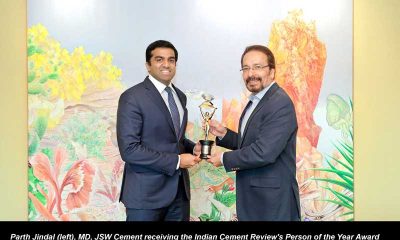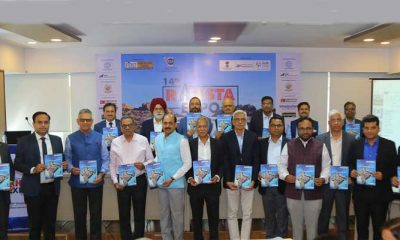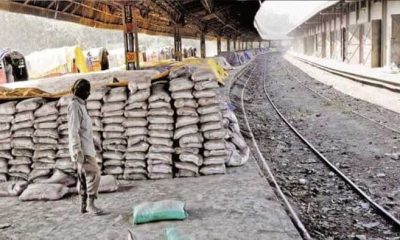Process
Cement Material Handling: Doubling in Size
Published
13 years agoon
By
admin
The Rs 2,000 crore material handling equipment for cement industry is poised to double its size in coming years. Currently, there are 87 projects worth Rs 85,000 crore under various stages of implementation entailing a total production capacity of 175 million tonne. Assuming investment of 15 to 20 per cent goes into material handling equipment, an additional business worth Rs 12,750 crore or Rs 2,500 crore per annum will be generated in the next 4 to 5 years, finds Nitin Madkaikar, FIRST Infocentre.Materials handling account for a significant portion of the total cost of producing cement. Workers and materials have to travel long distances in the course of the manufacturing process leading to loss of time and energy while nothing is added to the value of the product. Through effective plant and equipment, much material handling operations can be mechanised and shorten process duration. The choice of material handling methods and equipment is an integral part of the plant layout design.In many factories either the initial layout are not well throughout or, as an enterprise expands or change some of its produce or processes, extra machines, equipment or offices are added wherever space could be found. In other cases temporary arrangements are made to cope with an emergency situation, such as the sudden increase in demand for the product; but then these arrangements remain on a permanent basis even if the situation that provoked them subsequently changes. The net result is that materials handling workers often make long, round about journeys in the course of the manufacturing process leading to a loss of time and energy without anything being added to the value of the product.The major operations carried out in a typical cement plant are as follows:
- Crushing of limestone, coal, and other materials
- Storage arid blending of raw materials
- Preparation of raw mix
- Raw mix grinding and homogenisation
- Pyroprocessing of raw materials in the kiln
- Cooling and storage of clinker
- Grinding of clinker with gypsum to cement
- Storage and dispatch of cement
Materials handling operationsRaw material preparation includes a variety of blending and sizing (grinding) operations that are designed to provide a feed with appropriate chemical and physical properties. The raw material processing operations differ somewhat for wet and dry processes.Materials transport associated with dry raw milling systems can be accomplished by a variety of mechanisms, including screw conveyors, belt conveyors, drag conveyors, bucket elevators, air slide conveyors, and pneumatic conveying systems. The dry raw mix is pneumatically blended and stored in specially constructed silos until it is fed to the pyroprocessing system. In the wet process, water is added to the raw mill during the grinding of the raw materials in ball or tube mills, thereby producing a pumpable slurry, or slip, of approximately 65 per cent solids. The slurry is agitated, blended, and stored in various kinds and sizes of cylindrical tanks or slurry basins until it is fed to the pyroprocessing system.The final step in Portland cement manufacturing involves a sequence of blending and grinding operations that transforms clinker to finished portland cement. Up to 5 per cent gypsum or natural anhydrite is added to the clinker during grinding to control the cement setting time, and other specialty chemicals are added as needed to impart specific product properties. This finish milling is accomplished almost exclusively in ball or tube mills. Typically, finishing is conducted in a closed-circuit system, with product sizing by air separation.The finished portland cement is conveyed to bulk storage silos from which it is dispensed for transportation to consuming markets. Portland cement is often loaded in bulk into hopper trucks or rail. It is also packaged in 50 kg bags made of paper or jute. The bags are loaded onto pallets for handling, warehousing, and transporting.Process fugitive emission sources include materials handling and transfer, raw milling operations in dry process facilities, and finish milling operations.Emissions during handlingIn the raw mill, the raw material feeders, stackers, blenders and reclaimers can be a source of fugitive dust emissions. Transfer points on belt conveyor systems and bucket elevators that transport raw materials from storage to the raw mill department can also generate fugitive dust. Dry raw mills and the auxillary equipment are all designed to run under negative pressure to suppress particulate emissions.During colder weather vents from dryers, raw mills and air separators may exhibit a steam plume that may be mistaken for particulate emissions. Fabric filters in the vent circuits for dryers, raw mills, and air separators must be insulated to prevent internal moisture condensation.Dust in the clinker has a tendency to become airborne during handling. The free fall of clinker onto storage piles usually creates fugitive particulate emissions. Fugitive dust emissions from open storage piles are mitigated by rain and snow which causes a crust to form on the piles. Clinker in open piles is usually reclaimed with mobile equipment, such as front-end loaders. Clinker in storage halls is frequently handled with overhead bucket cranes.In the finish mill, various material-handling system vents are the source of particulate matter emissions. In the bagging and loading operations, particulate emissions are generated from silo openings, cement handling equipment, and the various bulk and package loading operations. The dust generated during the loading of trucks and railcars is controlled by venting the transport vessel to a fabric filter.Modernisation of MHEUntil recently, pneumatic material conveying (air lift and screw pump) are being used in most cement plants for pulverised material conveying (e.g. raw meal, pulverised coal and cement). This system uses compressed air and is therefore very energy intensive compared to mechanical conveying systems. The main advantage of pneumatic conveying is its low maintenance requirement and operating flexibility.However, modern bucket elevators require less maintenance and offer considerable energy savings for transporting pulverised materials like raw meal and cement. These are now increasingly being used in the cement industries.Another development has been the dense phase conveying system. Unlike the pneumatic screw pump, this system moves material with low velocity, which significantly reduces power consumption.For handling dusty materials and also to avoid spillage and environmental pollution, pipe conveyor material transport systems are used. The advantages of this system are:
- Dust free transport of materials
- Zero spillage
- Ability to transport at steep angles
- Return belt can also be used for material transport
Air lift and screw pump systems when used for kiln feed, introduce a considerable amount of air into the top stage pre-heater cyclones which results in a larger quantity of kiln exit gases to be handled by the fan and requires a dust collecting system with a larger capacity. The effective temperature of raw meal from the top cyclone is also reduced, adversely affecting fuel consumption. Thus, in modern plants invariably bucket elevators are used for kiln feed, which saves both heat and electrical energy.Material Handling and EnvironmentThe emission during materials handling in cement industry has been a cause of concern until technology stepped in and cement manufacturers abided to environment pollution norms. Explains P B Ravikumar, Chief Executive Officer, GMV Projects and Systems "Gone are the days, when heavily polluting equipments were installed with name sake dust collectors for the sake of pollution control boards. Now even the operators of the machines are well informed and demand better operating conditions. Companies are repeatedly selecting environmental-friendly methods like water spray, etc." While on increased cost of equipments he stated that "There is no question of any premium. Environment-friendly feature will be a basic necessity. Best performance feedback from actual users will be the premium for all suppliers.On domestic availability of equipment Ravikumar believes that Indigenous designers mostly bench mark their products and does not have a research back up. Imported qualities are far better and have a researched development background. GMV has developed a complete range of alternate fuel handling system for cement plants to use waste fuels like plastic, municipal waste, moulded parts, coconut kernels, rice husk, paint sludge etcTechnical layout of MHE in cement plantsConventionally F K pumps and airlifts were used for raw meal transport to blending silo, for kiln feed and for cement transport to cement silo. F K pumps and airlifts use compressed air thus consuming major share of power. Replacing F K pumps and air lifts with bucket elevator for blending silo/cement silo, kiln feed can make substantial saving in power. This can be made possible by locating the blending silo and cement silos near the raw mill and cement mill building respectively.As far as possible, a streamlined layout should lead to minimum number of transfer towers in order to reduce the number of belt conveyors. Use of conveyor belt in diagonal direction can reduce the number of belts. Thus saving on an additional drive of belt conveyor, transfer tower, bag filter, lighting arrangement for transfer tower can save lot of energy.Crusher and screen station can be located in the quarry itself so as to convey the screened material through cross-country belt. The movement of dumpers can be avoided by this and also can avoid the reject handling, thus substantial saving on the fuel can be achieved through this.Prospects for MHE in cement industryThe Rs 2,000 crore material handling equipment for cement industry is poised for the tremendous growth in coming years. As of June 2011, there were 87 cement projects under various stages of implementation entailing a total production capacity of 175 million tonne. The total investment envisaged on these projects is Rs 85,000 crore and are schedule for completion in next 4-5 years. Assuming a typical one million tonne cement plant invests about 15 to 20 per cent of the total project cost in material handling equipments. This implies a total additional business of Rs 12,750 crore to Rs 17,000 crore or Rs 2,500 crore per annum on an average. Further another 290 million tonne worth of projects are being planned or have been announced. This would provide further impetus to the material handling equipment industry. The need of the hour is technology upgradation as demand for world class equipments will be the basic necessity of this fresh demand.
Process
Price hikes, drop in input costs help cement industry to post positive margins: Care Ratings
Published
2 years agoon
October 21, 2021By
admin
Region-wise,the southern region comprises 35% of the total cement capacity, followed by thenorthern, eastern, western and central region comprising 20%, 18%, 14% and 13%of the capacity, respectively.
The cement industry is expected to post positive margins on decent price hikes over the months, falling raw material prices and marked drop in overall production costs, said an analysis of Care Ratings.
Wholesale and retail prices of cement have increased 11.9% and 12.4%, respectively, in the current financial year. As whole prices have remained elevated in most of the markets in the months of FY20, against the corresponding period of the previous year.
Similarly, electricity and fuel cost have declined 11.9% during 9M FY20 due to drop in crude oil prices. Logistics costs, the biggest cost for cement industry, has also dropped 7.7% (selling and distribution) as the Railways extended the benefit of exemption from busy season surcharge. Moreover, the cost of raw materials, too, declined 5.1% given the price of limestone had fallen 11.3% in the same aforementioned period, the analysis said.
According to Care Ratings, though the overall sales revenue has increased only 1.3%, against 16% growth in the year-ago period, the overall expenditure has declined 3.2% which has benefited the industry largely given the moderation in sales.
Even though FY20 has been subdued in terms of production and demand, the fall in cost of production has still supported the cement industry by clocking in positive margins, the rating agency said.
Cement demand is closely linked to the overall economic growth, particularly the housing and infrastructure sector. The cement sector will be seeing a sharp growth in volumes mainly due to increasing demand from affordable housing and other government infrastructure projects like roads, metros, airports, irrigation.
The government’s newly introduced National Infrastructure Pipeline (NIP), with its target of becoming a $5-trillion economy by 2025, is a detailed road map focused on economic revival through infrastructure development.
The NIP covers a gamut of sectors; rural and urban infrastructure and entails investments of Rs.102 lakh crore to be undertaken by the central government, state governments and the private sector. Of the total projects of the NIP, 42% are under implementation while 19% are under development, 31% are at the conceptual stage and 8% are yet to be classified.
The sectors that will be of focus will be roads, railways, power (renewable and conventional), irrigation and urban infrastructure. These sectors together account for 79% of the proposed investments in six years to 2025. Given the government’s thrust on infrastructure creation, it is likely to benefit the cement industry going forward.
Similarly, the Pradhan Mantri Awaas Yojana, aimed at providing affordable housing, will be a strong driver to lift cement demand. Prices have started correcting Q4 FY20 onwards due to revival in demand of the commodity, the agency said in its analysis.
Industry’s sales revenue has grown at a CAGR of 7.3% during FY15-19 but has grown only 1.3% in the current financial year. Tepid demand throughout the country in the first half of the year has led to the contraction of sales revenue. Fall in the total expenditure of cement firms had aided in improving the operating profit and net profit margins of the industry (OPM was 15.2 during 9M FY19 and NPM was 3.1 during 9M FY19). Interest coverage ratio, too, has improved on an overall basis (ICR was 3.3 during 9M FY19).
According to Cement Manufacturers Association, India accounts for over 8% of the overall global installed capacity. Region-wise, the southern region comprises 35% of the total cement capacity, followed by the northern, eastern, western and central region comprising 20%, 18%, 14% and 13% of the capacity, respectively.
Installed capacity of domestic cement makers has increased at a CAGR of 4.9% during FY16-20. Manufacturers have been able to maintain a capacity utilisation rate above 65% in the past quinquennium. In the current financial year due to the prolonged rains in many parts of the country, the capacity utilisation rate has fallen from 70% during FY19 to 66% currently (YTD).
Source:moneycontrol.com
Process
Wonder Cement shows journey of cement with new campaign
Published
2 years agoon
October 21, 2021By
admin
The campaign also marks Wonder Cement being the first ever cement brand to enter the world of IGTV…
ETBrandEquity
Cement manufacturing company Wonder Cement, has announced the launch of a digital campaign ‘Har Raah Mein Wonder Hai’. The campaign has been designed specifically to run on platforms such as Instagram, Facebook and YouTube.
#HarRaahMeinWonderHai is a one-minute video, designed and conceptualised by its digital media partner Triature Digital Marketing and Technologies Pvt Ltd. The entire journey of the cement brand from leaving the factory, going through various weather conditions and witnessing the beauty of nature and wonders through the way until it reaches the destination i.e., to the consumer is very intriguing and the brand has tried to showcase the same with the film.
Sanjay Joshi, executive director, Wonder Cement, said, "Cement as a product poses a unique marketing challenge. Most consumers will build their homes once and therefore buy cement once in a lifetime. It is critical for a cement company to connect with their consumers emotionally. As a part of our communication strategy, it is our endeavor to reach out to a large audience of this country through digital. Wonder Cement always a pioneer in digital, with the launch of our IGTV campaign #HarRahMeinWonderHai, is the first brand in the cement category to venture into this space. Through this campaign, we have captured the emotional journey of a cement bag through its own perspective and depicted what it takes to lay the foundation of one’s dreams and turn them into reality."
The story begins with a family performing the bhoomi poojan of their new plot. It is the place where they are investing their life-long earnings; and planning to build a dream house for the family and children. The family believes in the tradition of having a ‘perfect shuruaat’ (perfect beginning) for their future dream house. The video later highlights the process of construction and in sequence it is emphasising the value of ‘Perfect Shuruaat’ through the eyes of a cement bag.
Tarun Singh Chauhan, management advisor and brand consultant, Wonder Cement, said, "Our objective with this campaign was to show that the cement produced at the Wonder Cement plant speaks for itself, its quality, trust and most of all perfection. The only way this was possible was to take the perspective of a cement bag and showing its journey of perfection from beginning till the end."
According to the company, the campaign also marks Wonder Cement being the first ever cement brand to enter the world of IGTV. No other brand in this category has created content specific to the platform.
Process
In spite of company’s optimism, demand weakness in cement is seen in the 4% y-o-y drop in sales volume. (Reuters)
Published
2 years agoon
October 21, 2021By
admin
Cost cuts and better realizations save? the ?day ?for ?UltraTech Cement, Updated: 27 Jan 2020, Vatsala Kamat from Live Mint
Lower cost of energy and logistics helped Ebitda per tonne rise by about 29% in Q3
Premiumization of acquired brands, synergistic?operations hold promise for future profit growth Topics
UltraTech Cement
India’s largest cement producer UltraTech Cement Ltd turned out a bittersweet show in the December quarter. A sharp drop in fuel costs and higher realizations helped drive profit growth. But the inherent demand weakness was evident in the sales volumes drop during the quarter.
Better realizations during the December quarter, in spite of the 4% year-on-year volume decline, minimized the pain. Net stand-alone revenue fell by 2.6% to ?9,981.8 crore.
But as pointed out earlier, lower costs on most fronts helped profitability. The chart alongside shows the sharp drop in energy costs led by lower petcoke prices, lower fuel consumption and higher use of green power. Logistics costs, too, fell due to lower railway freight charges and synergies from the acquired assets. These savings helped offset the increase in raw material costs.
The upshot: Q3 Ebitda (earnings before interest, tax, depreciation and amortization) of about ?990 per tonne was 29% higher from a year ago. The jump in profit on a per tonne basis was more or less along expected lines, given the increase in realizations. "Besides, the reduction in net debt by about ?2,000 crore is a key positive," said Binod Modi, analyst at Reliance Securities Ltd.

Graphic by Santosh Sharma/Mint
What also impressed analysts is the nimble-footed integration of the recently merged cement assets of Nathdwara and Century, which was a concern on the Street.
Kunal Shah, analyst (institutional equities) at Yes Securities (India) Ltd, said: "The company has proved its ability of asset integration. Century’s cement assets were ramped up to 79% capacity utilization in December, even as they operated Nathdwara generating an Ebitda of ?1,500 per tonne."
Looks like the demand weakness mirrored in weak sales during the quarter was masked by the deft integration and synergies derived from these acquired assets. This drove UltraTech’s stock up by 2.6% to ?4,643 after the Q3 results were declared on Friday.
Brand transition from Century to UltraTech, which is 55% complete, is likely to touch 80% by September 2020. A report by Jefferies India Pvt. Ltd highlights that the Ebitda per tonne for premium brands is about ?5-10 higher per bag than the average (A cement bag weighs 50kg). Of course, with competition increasing in the arena, it remains to be seen how brand premiumization in the cement industry will pan out. UltraTech Cement scores well among peers here.
However, there are road bumps ahead for the cement sector and for UltraTech. Falling gross domestic product growth, fiscal slippages and lower budgetary allocation to infrastructure sector are making industry houses jittery on growth. Although UltraTech’s management is confident that cement demand is looking up, sustainability and pricing power remains a worry for the near term.

RAHSTA to showcase cutting-edge road construction tech, says NCC Director

RAHSTA will drive road construction innovation: Sundaresan

New appointment at TMEIC

Social Impact Award for Ambuja Cements

UCWL unveils new plant in Dabok, Udaipur

Environment Ministry revises rules of solid waste management

M-sand boards new terrain

Process and quality optimization in cement plant.
Concrete: A Highly Sustainable Building Material

Adani Group eyes Jaiprakash Associates’ Shahabad cement plant
Trending News
-

 Concrete1 month ago
Concrete1 month ago15th Cement EXPO to be held in March 2025 in Hyderabad
-

 Economy & Market2 weeks ago
Economy & Market2 weeks agoRoad construction industry to launch RAHSTA Expo 2024
-

 Economy & Market1 week ago
Economy & Market1 week agoRoad construction leaders launch RAHSTA Expo 2024 in Delhi
-

 Economy & Market2 weeks ago
Economy & Market2 weeks agoRoad construction industry launches RAHSTA Expo 2024 in Delhi













